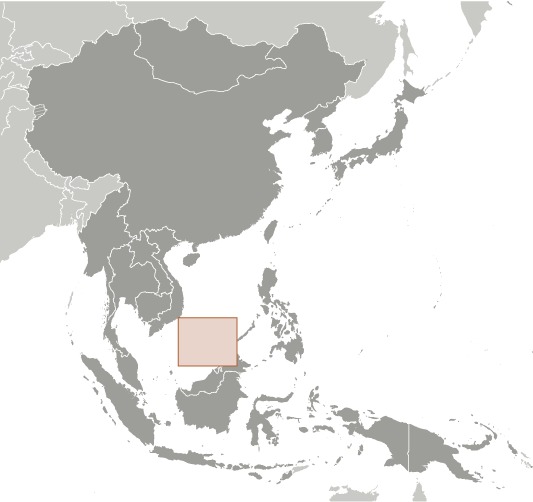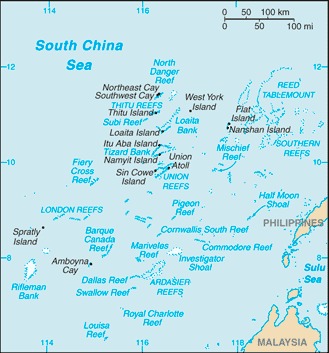

-
Introduction :: Spratly Islands
-
Background:The Spratly Islands consist of more than 100 small islands or reefs surrounded by rich fishing grounds - and potentially by gas and oil deposits. They are claimed in their entirety by China, Taiwan, and Vietnam, while portions are claimed by Malaysia and the Philippines. About 45 islands are occupied by relatively small numbers of military forces from China, Malaysia, the Philippines, Taiwan, and Vietnam. Since 1985 Brunei has claimed a continental shelf that overlaps a southern reef but has not made any formal claim to the reef. Brunei claims an exclusive economic zone over this area.
-
Geography :: Spratly Islands
-
Location:Southeastern Asia, group of reefs and islands in the South China Sea, about two-thirds of the way from southern Vietnam to the southern PhilippinesGeographic coordinates:8 38 N, 111 55 EMap references:Southeast AsiaArea:total: 5 sq km less thanland: 5 sq km less thanwater: 0 sq km
note: includes 100 or so islets, coral reefs, and sea mounts scattered over an area of nearly 410,000 sq km (158,000 sq mi) of the central South China Sea
country comparison to the world: 250Area - comparative:land area is about seven times the size of the National Mall in Washington, DCLand boundaries:0 kmCoastline:926 kmMaritime claims:NAClimate:tropicalTerrain:small, flat islands, islets, cays, and reefsElevation:lowest point: South China Sea 0 mhighest point: unnamed location on Southwest Cay 6 mNatural resources:fish, guano, undetermined oil and natural gas potentialLand use:agricultural land: 0% (2011 est.)arable land: 0% (2011 est.) / permanent crops: 0% (2011 est.) / permanent pasture: 0% (2011 est.)forest: 0% (2011 est.)other: 100% (2011 est.)Natural hazards:typhoons; numerous reefs and shoals pose a serious maritime hazardEnvironment - current issues:China's use of dredged sand and coral to build artificial islands harms reef systems; illegal fishing practices indiscriminately harvest endangered species, including sea turtles and giant clamsGeography - note:strategically located near several primary shipping lanes in the central South China Sea; includes numerous small islands, atolls, shoals, and coral reefs -
People and Society :: Spratly Islands
-
Population:no indigenous inhabitants
note: there are scattered garrisons occupied by military personnel of several claimant states
-
Government :: Spratly Islands
-
Country name:conventional long form: noneconventional short form: Spratly Islandsetymology: named after a British whaling captain Richard SPRATLY, who sighted Spratly Island in 1843; the name of the island eventually passed to the entire archipelago
-
Economy :: Spratly Islands
-
Economic overview:Economic activity is limited to commercial fishing. The proximity to nearby oil- and gas-producing sedimentary basins indicate potential oil and gas deposits, but the region is largely unexplored. No reliable estimates of potential reserves are available. Commercial exploitation has yet to be developed.Ease of Doing Business Index scores:
-
Transportation :: Spratly Islands
-
Airports:8 (2020)country comparison to the world: 162Airports - with paved runways:total: 6 (2020)2,438 to 3,047 m: 3914 to 1,523 m: 2under 914 m: 1Airports - with unpaved runways:total: 2 (2020)914 to 1,523 m: 2Heliports:5 (2020)Ports and terminals:none; offshore anchorage only
-
Military and Security :: Spratly Islands
-
Military - note:Spratly Islands consist of more than 100 small islands or reefs of which about 45 are claimed and occupied by China, Malaysia, the Philippines, Taiwan, and Vietnam
China: assessed to have 7 outposts (Fiery Cross, Mischief, Subi, Cuarteron, Gavin, Hughes, and Johnson reefs); the outposts on Fiery Cross, Mischief, and Subi include air bases with helipads and dozens of fighter jet hangers, naval port facilities, surveillance radars, air defense sites, anti-ship cruise missiles, and other military infrastructure such as communications, barracks, maintenance facilities, and ammunition and fuel bunkers
Malaysia: assessed to have 5 outposts in the southern portion of the archipelago, closest to the Malaysian state of Sabah (Ardasier Reef, Eric Reef, Mariveles Reef, Shallow Reef, and Investigator Shoal); all the outposts have helicopter landing pads, while Shallow Reef also has an airstrip
Philippines: assessed to occupy 9 features (Commodore Reef, Second Thomas Shoal, Flat Island, Loaita Cay, Loaita Island, Nanshan Island, Northeast Cay, Thitu Island, and West York Island); Thitu Island has the only Philippine airstrip in the Spratlys
Taiwan: maintains an outpost with an airstrip on Itu Aba Island
Vietnam: assessed to occupy about 49 outposts spread across 27 features, including facilities on 21 rocks and reefs in the Spratlys, plus 14 platforms known as “economic, scientific, and technological service stations,” or Dịch vụ-Khoa (DK1), on six underwater banks to the southeast that Vietnam does not consider part of the disputed island chain, although China and Taiwan disagree; Spratly Islands outposts are on Alison Reef, Amboyna Cay, Barque Canada Reef, Central Reef, Collins Reef, Cornwallis South Reef, Discovery Great Reef, East Reef, Grierson Reef, Ladd Reef, Landsdowne Reef, Namyit Island, Pearson Reef, Petley Reef, Sand Cay, Sin Cowe Island, South Reef, Southwest Cay, Spratly Island, Tennent Reef, West Reef; Spratly Island includes an airstrip with aircraft hangers; the six underwater banks with outposts include Vanguard, Rifleman, Prince of Wales, Prince Consort, Grainger, and Alexandra
(2020) -
Transnational Issues :: Spratly Islands
-
Disputes - international:
all of the Spratly Islands are claimed by China (including Taiwan) and Vietnam; parts of them are claimed by Brunei, Malaysia and the Philippines; despite no public territorial claim to Louisa Reef, Brunei implicitly lays claim by including it within the natural prolongation of its continental shelf and basis for a seabed median with Vietnam; claimants in November 2002 signed the "Declaration on the Conduct of Parties in the South China Sea," which has eased tensions but falls short of a legally binding "code of conduct"; in March 2005, the national oil companies of China, the Philippines, and Vietnam signed a joint accord to conduct marine seismic activities in the Spratly Islands